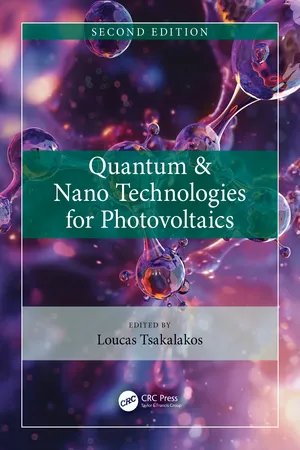
- English
- ePUB (mobile friendly)
- Available on iOS & Android
Quantum & Nano Technologies for Photovoltaics
About this book
Ongoing concerns regarding greenhouse gas-related environmental effects, energy security, and the rising costs of conventional energy sources has led to sustained interest and growth in solar energy in general, and photovoltaics in particular. Exploring state-of-the-art developments from a practical point of view, Quantum and Nanotechnology for Photovoltaics is the second edition of the book and examines issues in increasing efficiency, decreasing costs, and how these two goals can be achieved in a single photovoltaic device leveraging emergent quantum and nanoscale phenomena.
The book provides fundamental background, including new chapters on quantum physics, hot carrier solar cells, luminescent solar concentrators, and additional topics, and places research approaches within the proper physical context as related to photovoltaics performance enhancement. It reviews the applications of devices and their performance requirements, followed by coverage of thin films and advanced band structure concepts for obtaining efficiencies above the Shockley–Queisser single band-gap efficiency limit of 31%. The editor and contributors also discuss the basic optical properties of nanostructured materials as related to photovoltaics applications and describes quantum hot-carrier device physics related to performance. They then explore recent literature in the application of various classes of nanostructures to photovoltaics. The book covers solar cells based on hybrid organic-inorganic nanocomposites structures, quantum wells, nanowires/tubes, and quantum dots. It also discusses the use of nanoparticles/quantum dots to enhance the performance of conventional solar cells and quantum-enhanced luminescent solar concentrators.
Each chapter summarizes the historical development for the nanostructure class under consideration, applications beyond photovoltaics, and the major synthetic methods, followed by a critique of leading works that have employed the particular quantum and/or nanostructure type. The book examines the advantages of each quantum/nanostructure approach and the remaining technical challenges, with an emphasis on possible future areas of research interest. This work is intended for academic and industrial researchers developing new photovoltaic technologies, primarily at the graduate level and beyond, though senior-level undergraduates with appropriate training in physics and materials science will also benefit from this book. Many of the chapters also constitute useful background knowledge for managers and decision-makers in companies developing advanced photovaltaic, energy, and materials technologies.
Frequently asked questions
- Essential is ideal for learners and professionals who enjoy exploring a wide range of subjects. Access the Essential Library with 800,000+ trusted titles and best-sellers across business, personal growth, and the humanities. Includes unlimited reading time and Standard Read Aloud voice.
- Complete: Perfect for advanced learners and researchers needing full, unrestricted access. Unlock 1.4M+ books across hundreds of subjects, including academic and specialized titles. The Complete Plan also includes advanced features like Premium Read Aloud and Research Assistant.
Please note we cannot support devices running on iOS 13 and Android 7 or earlier. Learn more about using the app.
Information
Table of contents
- Cover
- Half Title
- Title
- Copyright
- Contents
- Editor Biography
- Contributors
- Chapter 1 ◾ Introduction to Photovoltaic Physics, Applications, and Technologies
- Chapter 2 ◾ Introduction to Quantum Mechanics
- Chapter 3 ◾ Optical Properties of Nanostructures
- Chapter 4 ◾ Hot-Carrier Extraction: Application to Solar Photovoltaics and Solar-Fuel Production
- Chapter 5 ◾ Nanostructured Organic Solar Cells
- Chapter 6 ◾ Novel Nano-Photovoltaic Phenomena in Quantum Well Solar Cells
- Chapter 7 ◾ Applications of Nano-Photovoltaics to the Artificial Leaf and Other Examples of Biomimicry
- Chapter 8 ◾ Nanowire- and Nanotube-Based Solar Cells
- Chapter 9 ◾ Semiconductor Nanowires: Contacts and Electronic Properties
- Chapter 10 ◾ Quantum Dot Solar Cells
- Chapter 11 ◾ Luminescent Solar Concentrators
- Chapter 12 ◾ Nanoparticles for Solar Spectrum Conversion
- Chapter 13 ◾ Epilogue: Future Manufacturing Methods for Nanostructured Photovoltaic Devices
- Index